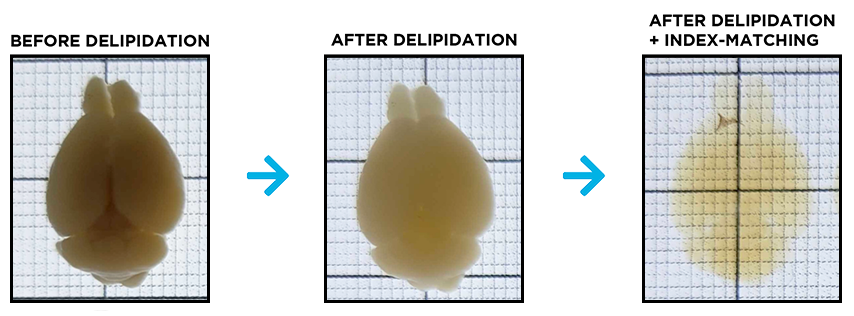Passive Delipidation Protocol
Reagents Required
- Delipidation Buffer – stored at RT
- Temperature-controlled shaking incubator capable of 37-45°C
Protocol
[Note] If you are working with <500 um slices, refer to the Thin Slice SHIELD protocol which includes recommendations for delipidation.
1. Incubate the sample in ~20 mL Delipidation Buffer at 45°C with shaking.
[Note] If you want to stain your sample with SYTO16 or Propidium Iodide, you can do this passively while the sample is being cleared. To do so, simply add dye to the tube in a 1:1000 dilution.
Incubation times (no need to refresh solution):
- Whole mouse brains: 1 week at 45°C
- Mouse brain hemispheres: 5 days at 45°C
- As a rule, larger tissues take longer to delipidate. For larger samples, you may need to test the required incubation time empirically.
If you do not have a 45°C incubator, you may incubate at 37°C as well. Incubation times are as follows:
- Whole mouse brains: 11 days at 37°C
- Mouse brain hemispheres: 7 days at 37°C
At the end of delipidation, the samples will not be completely transparent and should not have changed size. You will not be able to tell that the sample is done clearing until the index matching stage. See images below.

2. The samples can be stored at 4°C in PBS with 0.02% sodium azide until you are ready for index matching or immunolabeling.
[Note]: Unique Tissue Types
- If your sample is liver, we have found that an additional step will result in more transparent samples. Please follow the Liver Clearing Protocol to complete clearing of livers after Step 1 in the protocol above.
- If your sample contains significant connective tissue, adipose tissue, or skin (such as with whole mouse heads), we have found that an additional dehydrating clearing step helps clear these other tissue types without damaging fluorescent proteins. Please follow the fDisco protocol after completing Step 1 in the protocol above. Please note that this step has the potential to harm antigenicity. This step can also be moved to after immunolabeling if you find that to be the case.
